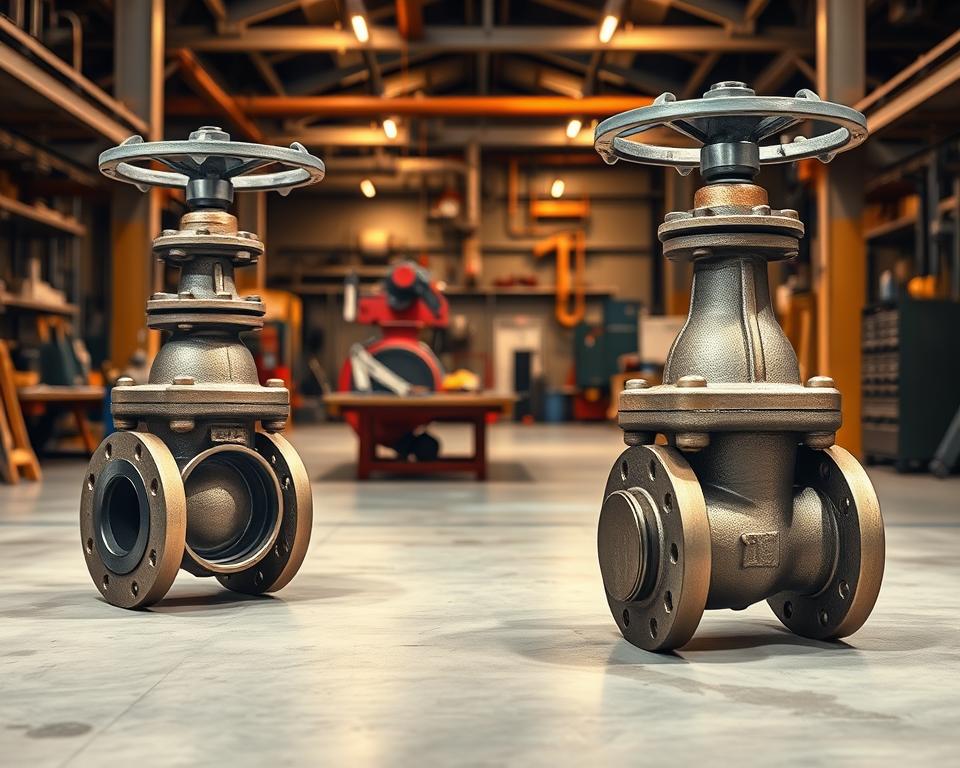Cast-Iron Gate Valves: Key Features, Advantages, and Applications
Could a single, well-made valve cut maintenance time and keep water systems running longer?
I manufacture and supply Cast Iron Gate Valve Manufacturer at Yaxing Valve, and I back their build quality and support for U.S. customers. This line is engineered for longevity in waterworks and light-industrial systems.
Each gate valve has a robust iron body, a machined wedge path, and straightforward handwheel operation. The result is dependable shutoff, simple maintenance, and consistent performance in buildings, fire mains, and utility distribution lines.
I work with specifiers to speed submittals and deliver clear details: sizes, connection types, pressure classes, and optional accessories. We retain cart and preference data (cookies) to make reorders simple.
If you need a practical replacement or a cost-effective option for new projects, compare these cast-iron gate valve advantages against your current hardware to see lifecycle value and real-world fit.
Why Yaxing Valve Cast Iron Gate Valves Deliver Reliable Flow Control
I verify each Yaxing Valve product myself to confidently recommend it for demanding U.S. applications.
Rugged cast-iron body engineered for industrial performance
Every valve features a strong cast-iron body that resists load-induced deformation. Metal-to-metal seating and precise machining ensure tight shutoff when customers need it most.

Shaped for maximum flow and low pressure drop
The internal path is optimized to lower turbulence and pressure loss. That helps pumps run more efficiently and lowers energy use across systems.
- I validate product dimensions and testing to align with common ANSI standards and internal checks.
- I refine stem/wedge/bonnet interfaces to reduce friction and maintain consistent torque over time.
- I set body thickness targets for durability while keeping weight manageable for installers.
- Documentation lists tests/standards so purchasing can wrap orders quickly.
| Key Feature | Primary Benefit | Tech Note |
|---|---|---|
| Cast-iron body | Strong structural integrity | Meets dimensional stability targets |
| Optimized gate geometry | Reduced pressure drop | Boosts pump operating efficiency |
| Finished stem/handwheel interfaces | Smoother operation | Steady torque over service life |
| Test documentation | Speedier submittal clearance | ANSI-referenced reports |
Cast Iron Gate Valves: Materials, Design, and Performance Essentials
I outline the body, sealing, and stem choices to make selection and ordering straightforward.
Body, bonnet, and wedge materials
Material stack-up: cast-iron body and bonnet, precision-machined wedge, metal-to-metal seat interface for dependable isolation across water service and general industry.
Stem and Handwheel Options
I offer non-rising stem and inside screw stems for compact installations. Screw thread forms and packing arrangements are fully documented.
Performance limits and standards
I provide qualified pressure/temperature ranges and ANSI-aligned end connections so engineers can confirm fit without extra drawings.
- Interface between stem and handwheel tuned for consistent torque.
- Smooth internal geometry reduces headloss.
- Series identifiers and submittal-ready specs speed ordering and approvals.
| Item | Material/Type | Rating | Notes |
|---|---|---|---|
| Valve body/bonnet | cast iron | 150 psi | ANSI flange dimensions, welded/bolted options |
| Gate wedge | Machined metal | −20°–180°F range | Metal-to-metal seating, low headloss finish |
| Operating stem | Non-rising / inside screw | N/A | Documented thread and packing in datasheet |
| Model series | YX-100 and YX-200 | 2″ to 12″ sizes | Simple part numbering |
Modern Applications, Install, and Operation
I help contractors and owners place these valves where they perform best in modern loops. The goal is straightforward selection, installation, and checks so crews complete commissioning without callbacks.
Use cases: waterworks, building systems, general industry
Select full-port units for low restriction across long mains, service feeds, and bypass lines.
For mechanical rooms and industrial loops with limited headroom, I favor non-rising stem or inside-screw designs.
Installation guidelines
Protect the body during handling by lifting at rated points and avoiding flange stress. Confirm alignment prior to final torque to prevent distortion/leaks.
Choose media-compatible gaskets, use a cross-torque sequence, and provide supports to prevent sag.
Operation & maintenance notes
Position the handwheel for easy access and verify free movement after packing tweaks.
Perform periodic torque checks under pressure, inspect the wedge and packing, and confirm the pressure/temperature range against your media. Capture tag IDs in your account and link CMMS work orders.
| Topic | Action | When | Result |
|---|---|---|---|
| Use-case mapping | Select full-bore for mains; non-rising for tight spaces | Design stage | Reduced headloss and saved space |
| Handling/installation | Lift properly, align, then cross-torque bolts | Field install | Prevents leaks and flange distortion |
| Commissioning checks | Confirm handwheel feel; perform pressure tests | Startup and routine | Stable operation with reliable shutoff |
| Maintenance tracking | Tag valves and link to account/CMMS | Ongoing cycle | Speedy parts ID and replacements |
Proper handling and commissioning extend service life and keep the Resilient Seated Gate Valve looking and working like new.
Work with Me at Yaxing Valve to Specify the Right Iron Gate Valve Today
Contact me with your line size, pressure expectations, and flow needs and I will match the exact series and type to your duty range and temperature limits.
My concise checklist speeds approvals: end type, inside-screw vs non-rising, and handwheel orientation. I also note stem handwheel and screw details for clear install guidance.
See the gallery for high-res images and layout views that show clearance and operator reach. Make an account to save specs, tag valves, and link drawings plus a one-page field PDF.
Ask for a quick quote and I’ll confirm availability, lead times, alternates, and help you complete the order while you view the gallery. I use cookies only to keep your account session and cart ready.
